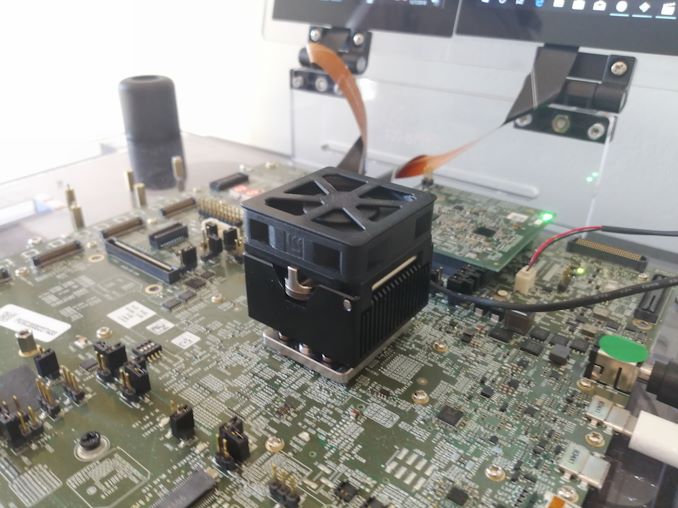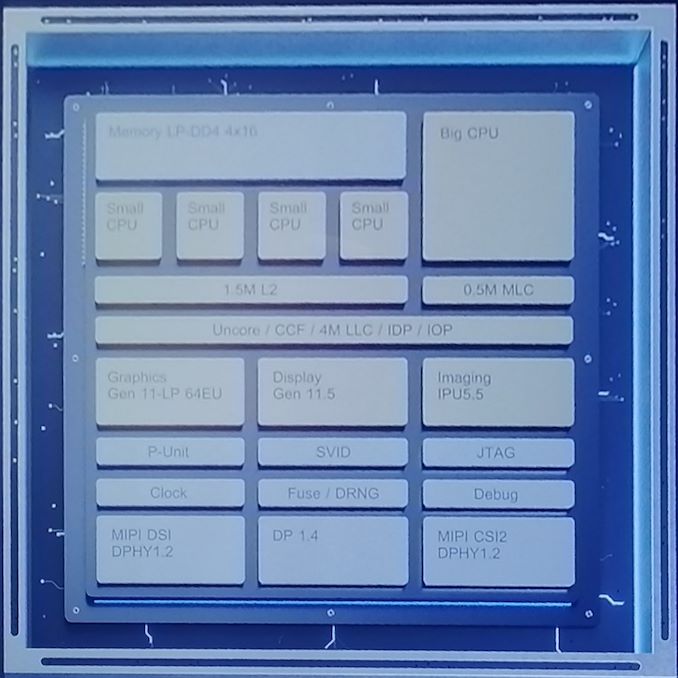Intel's Architecture Day 2018: The Future of Core, Intel GPUs, 10nm, and Hybrid x86
by Dr. Ian Cutress on December 12, 2018 9:00 AM EST- Posted in
- CPUs
- Memory
- Intel
- GPUs
- DRAM
- Architecture
- Microarchitecture
- Xe
Intel’s First Fovoros and First Hybrid x86 CPU: Core plus Atom in 7 W on 10 nm
Perhaps someone will correct me, but I can’t ever remember a time when Intel has put multiple x86 cores of different configurations on the same bit of silicon (ed: Intel Edison). Ever since Arm starting doing it with its big.Little designs in smartphones, a perennial question was if Intel was going to do something similar, either with big and small Atom cores, or by moving a high-performance Core into the mix. When Intel left the smartphone and tablet market, we assumed the idea was dead. But, like a reanimated zombie, it has risen from the grave. Enter Intel’s Hybrid x86 CPU.
This tiny 12x12 package is built using Intel’s Fovoros technology, using a 22FFL IO chip as the active interposer connected with TSVs to a 10nm die that contains both a single Sunny Cove core and four Atom (Tremont?) cores. This tiny chip is smaller than a dime, and is designed to have a 2 mW standby power. It would appear that this chip is destined for mobile devices.
Here’s the manufacturing diagram, showing the idea that POP memory is placed over the Fovoros design to give the final product. Very much like a mobile chip.
The demo system that Intel had on display looked similar to the previous Sunny Cove design, however this heatsink was smaller and it had a few different connectors. We were told that this chip will support PCIe for M.2 as well as UFS, both of which are found in mobile. There also looked like a couple of SIM card connectors on this motherboard.
The key part of this discussion however is this block diagram that was on one of the Intel slides. Here we see a single ‘Big CPU’ with 0.5 MB of private medium level cache, four ‘Small CPU’s with a shared 1.5 MB L2 cache, an uncore that has 4MB of last level cache, a quad-channel memory controller (4x16-bit) with support for LPDDR4, a 64 EU design with Gen11 graphics, the Gen 11.5 display controller, a new IPU, MIPI support with DisplayPort 1.4, and all of this in a tiny package.
Seriously though, this has the potential to be a large revenue stream for Intel. They’ve made this chip, which allows the cores to enter C6 sleep states when not in use, that has a die size smaller than 12x12mm (144 mm2), and target the sub-7W fanless device market. That’s with a big Core, four Atom cores, and a GT2 64 EU design.
Intel actually says that the reason why this product came about is because a customer asked for a product of about this performance but with a 2 mW standby power state. In order to do this, Intel created and enhanced a number of technologies inside the company. The final product is apparently ideal for the customer, however the chip will also be made available for other OEMs.
In our Q&A session with the senior members of Intel, it was clear that this technology is still in its infancy, and Intel now has a new toy to play with. Jim Keller stated that internally they are trying lots of new things with this technology to see what works and what would make a good product, so we should be seeing more Foveros designs through 2019 and 2020.















148 Comments
View All Comments
Raqia - Thursday, December 13, 2018 - link
Your point is taken and Keller did say it was in its infancy, but I am interested in whether what we're seeing here will be a competitive product or will remain an interesting science experiment. There are theoretical benefits of stacking high performance dies on low leakage ones like this but also substantial challenges and deficiencies which the current iteration doesn't show that it has overcome. What we might see in benefit in terms of better overall area, lower package level fab rejection rates, and better net power characteristic could be offset by a worse concentration of heat and hence more throttling when both elements are running or more expensive packaging. Perhaps in the end, a monolithic die is a better compromise despite losing out on some metrics for mobile.nico_mach - Wednesday, December 12, 2018 - link
So the GPU is going to be called ... Ten to the Eeth power? Is that right?I reject all these Xes used in unpredictable ways. The iPhones are pronounced exar and excess. This is ecksee, and I still use oh ess ecks on my emm bee eh at home.
Jon Tseng - Wednesday, December 12, 2018 - link
>Intel actually says that the reason why this product came about is because a customer>asked for a product of about this performance but with a 2 mW standby power state.
Huh wonder who the customer for that Core/Atom hybrid is. Seems a bit overpowered for a tablet. A bit underpowered for a MacBook (or for a car). Chromebooks maybe but most are too low volume to demand a custom part (maybe the education market is taking off?). PC OEMs don't normally take such custom parts for their laptops. But the graphics loadout implies some kind of PC-type application?
Any ideas??
HStewart - Wednesday, December 12, 2018 - link
From the diagram, it appears that hybrid cpu - has single Core CPU with 4 small (Atom) CPU's - such technology is done with Samsung Processors - this would mean it still lower power - but still have primary single thread core speed.Most interesting would be how the smaller core are used in scheduling system. Most like means and enhancement in OS for proper usage.
A5 - Wednesday, December 12, 2018 - link
There aren't a ton of companies big enough to make Intel create a new product line just for them.The whole list is probably Apple/HP/Dell. Maybe Microsoft.
The_Assimilator - Wednesday, December 12, 2018 - link
Microsoft Surface, obviously. It's become a very profitable line for MS but the current models are either too battery-hungry (Core CPUs) or too slow (Atom CPUs). Fovoros will give the best of both these worlds while also being x86... priced right, a Fovoros-based Surface will essentially end any argument for iPads in a business environment, especially considering most software remains firmly single-threaded. But it remains to be seen whether (a) Intel can get the power down even further (7W is still double most smartphones) and (b) whether their big.LITTLE implementation is good enough.Raqia - Wednesday, December 12, 2018 - link
Windows on ARM will do just fine now that Visual Studio emits ARM native code. Once Chrome gets ported (and that will be soon https://www.neowin.net/news/both-chromium-and-fire... the platform should address 95% of typical daily use cases and provide substantial compatibility with legacy software / file formats. This is better value than iPads and upcoming dedicated SoCs like the 8cx should offer better performance and battery / heat characteristics than what Intel has planned for next year in the same power envelope.The_Assimilator - Thursday, December 13, 2018 - link
I think you missed the part where Windows on ARM is horribly slow and therefore shitty. As a result, Microsoft has no plans to port anything useful (e.g. Office) to ARM, which means Windows on ARM is stuck being the lowest of the low-end. And that's not a space that Surface is intended to play in; Surface is an iPad competitor, and an iPad competitor can't be slow and shitty. Business devices can't be slow and shitty, and they absolutely need to be able to run Office.I expect that either Windows on ARM will be allowed to wither and die once Fovoros ships, or it will languish in a dead zone whereby only the cheapest of the cheap devices by no-name-brand OEMs (think $100 Lenovo tablets) use ARM chips and hence need it.
So unless Qualcomm's 8cx is a game-changer in terms of performance, Fovoros should be the end of ARM on desktop, and thank fucking God for that.
Spunjji - Thursday, December 13, 2018 - link
Microsoft already have an Office code base on ARM, so I'm not sure what you're talking about there.What would worry me about an Intel BIG.little style design is that if Windows doesn't assign your performance-critical application to the correct (big) core, performance will mostly suck just as hard as if all your cores were Atom.
As such, I'd be cautious on calling a winner just yet.
gamerk2 - Thursday, December 13, 2018 - link
Agreed with this; Microsoft has been let down by Intel not having a good mobile platform. If it were up to them, they wouldn't bother with ARM, but they have to due to battery/power/heat requirements.